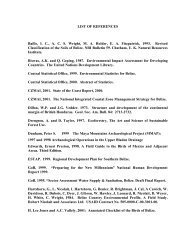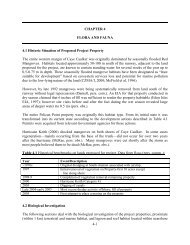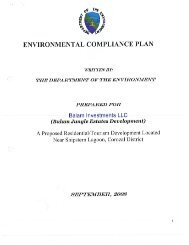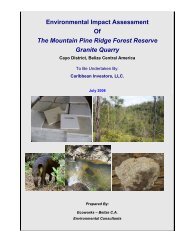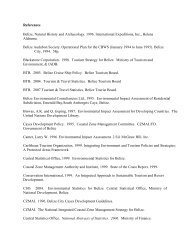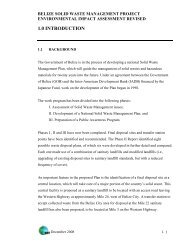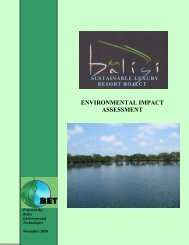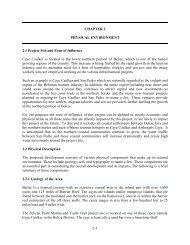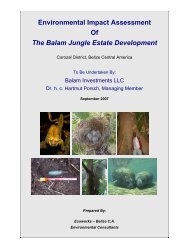Ambergris Caye Belize Resort Development - Department of ...
Ambergris Caye Belize Resort Development - Department of ...
Ambergris Caye Belize Resort Development - Department of ...
You also want an ePaper? Increase the reach of your titles
YUMPU automatically turns print PDFs into web optimized ePapers that Google loves.
description <strong>of</strong> the property. The situation <strong>of</strong> the lack <strong>of</strong> fishlife in the lagoon has also been<br />
cited by Grimshaw and Paz [2004] as the experience <strong>of</strong> other authors. It would be very unlikely<br />
that there would be no fishlife in the lagoon, since although it is understandable that ecological<br />
functions <strong>of</strong> the lagoon would change over annual cycles and longer time frames, it is unlikely<br />
that the changes encountererd, including that <strong>of</strong> fishing pressures, would be <strong>of</strong> a magnitude or<br />
orientation to completely wiped out the fish stocks from the area [Pers. comm.., G. Myvett].<br />
Much <strong>of</strong> the species encountered are stenohaline stocks that are incapable <strong>of</strong> withstanding<br />
freshwater influences and in general large shifts in salinity. The species encountererd by the<br />
Tunich Nah Survey Team, as well as those cited by Grimshaw and Paz [2004], typically<br />
includes reef species such as the Blue Tang (Acanthurus coeruleus), the Dog Snapper<br />
(Lutjanus jocu), and the Hogfish (Lachnolaimus maximus), as well as oceanic stocks such as<br />
the Greater Amberjack (Seriola dumerili), the Dolphinfish (Coryphaena hippurus) and the<br />
Houndfish (Tylosurus crocodilus) [See Table 2.4].<br />
Much <strong>of</strong> the euryhaline species, which can adjust to low salinity circumstances, and which can<br />
tolerate relatively wide variations in salinity, that were listed by Grimshaw and Paz [2004]<br />
were not seen or reported anectdotally by the Tunich Nah Survey Team for the proposed<br />
project area. These include species such as the Tarpon (Megalops atlanticus), the Snook<br />
(Centropomus undecimalis) and the White Mullet (Mugil curema) [See Table 2.4].<br />
The presence <strong>of</strong> euryhaline stocks in the Grimshaw and Paz endeavour [2004] relates to the<br />
fact that it is unlikely that these species were recorded in the immediate project area: Given the<br />
diversity <strong>of</strong> habitats and the expansive extent <strong>of</strong> the wider Bacalar Chico National Park and<br />
Marine Reserve [BCNP/MR], it is likely that the euryhaline stocks were documented or<br />
reported for some locale other than the current project site that would be characterized by low<br />
salinities and consequently significant freshwater inputs.<br />
2.3.1.2.2.2 Reptiles and Amphibians<br />
Grimshaw and Paz [2004] cited the existence <strong>of</strong> 33 reptiles in the larger BCNP/MR: These<br />
included 15 species <strong>of</strong> snakes and 1 crocodilian [See Table 2.5]. The Tunich Nah Survey Team<br />
documented 5 species <strong>of</strong> reptiles, with 2 species <strong>of</strong> snakes and no crocodilian [See Table 2.5].<br />
The limited number <strong>of</strong> reptilian species documented on the project site is a function <strong>of</strong> the size<br />
<strong>of</strong> the property, geography and ecological characterization. The property is a relatively thin<br />
strip <strong>of</strong> land with the sea on one side and a lagoon on the other. It’s geographic placement and<br />
size does not allow for the diversity and geographic extent <strong>of</strong> habitats that would allow for a<br />
wide array <strong>of</strong> species.<br />
The most abundant species documented by the Tunich Nah Team was the Wish-Willy, Spinytail<br />
Iguana (Ctenosaura similis), followed by the Smooth-Scaled Gecko<br />
2-55




